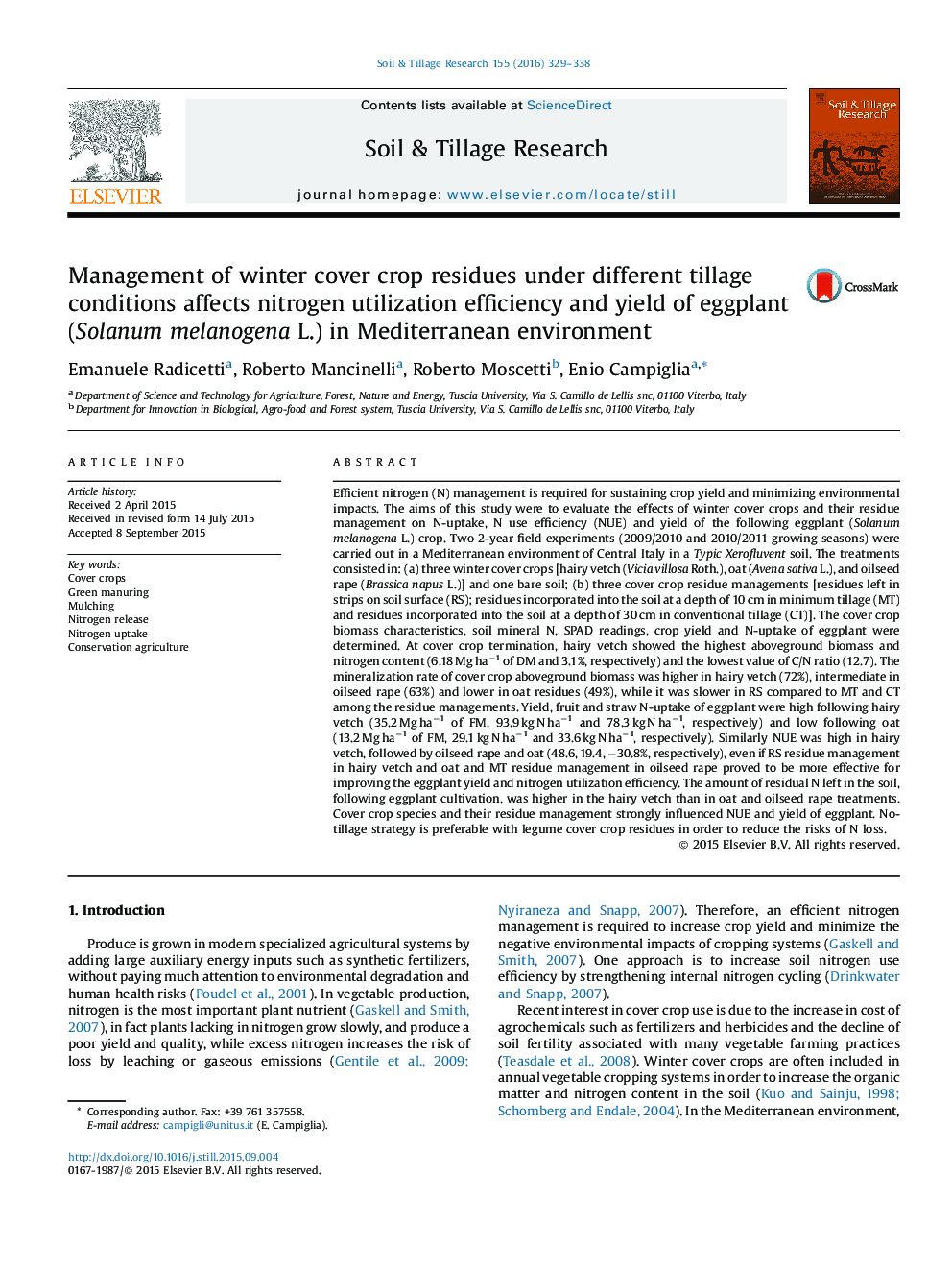| کد مقاله | کد نشریه | سال انتشار | مقاله انگلیسی | نسخه تمام متن |
|---|---|---|---|---|
| 305489 | 513031 | 2016 | 10 صفحه PDF | دانلود رایگان |

• Eggplant was grown after green manuring or mulching of winter cover crop residues.
• Mineralization rate of cover crop biomass was slower in RS compared to MT and CT.
• Eggplant yield and NUE were higher following hairy vetch and lower following oat.
• Mulching is preferable with legume cover crop residues to reduce the risks of N loss.
Efficient nitrogen (N) management is required for sustaining crop yield and minimizing environmental impacts. The aims of this study were to evaluate the effects of winter cover crops and their residue management on N-uptake, N use efficiency (NUE) and yield of the following eggplant (Solanum melanogena L.) crop. Two 2-year field experiments (2009/2010 and 2010/2011 growing seasons) were carried out in a Mediterranean environment of Central Italy in a Typic Xerofluvent soil. The treatments consisted in: (a) three winter cover crops [hairy vetch (Vicia villosa Roth.), oat (Avena sativa L.), and oilseed rape (Brassica napus L.)] and one bare soil; (b) three cover crop residue managements [residues left in strips on soil surface (RS); residues incorporated into the soil at a depth of 10 cm in minimum tillage (MT) and residues incorporated into the soil at a depth of 30 cm in conventional tillage (CT)]. The cover crop biomass characteristics, soil mineral N, SPAD readings, crop yield and N-uptake of eggplant were determined. At cover crop termination, hairy vetch showed the highest aboveground biomass and nitrogen content (6.18 Mg ha−1 of DM and 3.1%, respectively) and the lowest value of C/N ratio (12.7). The mineralization rate of cover crop aboveground biomass was higher in hairy vetch (72%), intermediate in oilseed rape (63%) and lower in oat residues (49%), while it was slower in RS compared to MT and CT among the residue managements. Yield, fruit and straw N-uptake of eggplant were high following hairy vetch (35.2 Mg ha−1 of FM, 93.9 kg N ha−1 and 78.3 kg N ha−1, respectively) and low following oat (13.2 Mg ha−1 of FM, 29.1 kg N ha−1 and 33.6 kg N ha−1, respectively). Similarly NUE was high in hairy vetch, followed by oilseed rape and oat (48.6, 19.4, −30.8%, respectively), even if RS residue management in hairy vetch and oat and MT residue management in oilseed rape proved to be more effective for improving the eggplant yield and nitrogen utilization efficiency. The amount of residual N left in the soil, following eggplant cultivation, was higher in the hairy vetch than in oat and oilseed rape treatments. Cover crop species and their residue management strongly influenced NUE and yield of eggplant. No-tillage strategy is preferable with legume cover crop residues in order to reduce the risks of N loss.
Journal: Soil and Tillage Research - Volume 155, January 2016, Pages 329–338